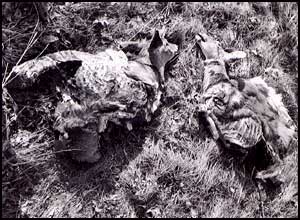










THE BLOWBACK FILES

Photo: Monica Lee Moore
Of the nine known planets that orbit our sun, Earth is the only planet known to support life. Yet the ability for the Earth to support all living creatures is in jeopardy. Global warming, destruction of the ozone layer, rising ocean levels, depleting supplies of fresh water, deforestation, and soil erosion are adversely affecting life on Earth and contributing to the largest-scale extinction since the time of the dinosaurs.
The Gaia Theory asserts that the Earth is alive and has the ability and capacity for self-correction that is characterized by all living organisms. This theory also asserts that all living organisms are interconnected; the Earth is not a machine. It is a living, breathing organism. The Deep Ecology Movement, an environmental movement defined by this interconnectedness, was born from supporters of the Gaia Theory.
According to the Gaia Theory, the Earth's living qualities emerge from the interactions of all living beings with each other and with other non-living parts of the environment, such as the rocks, the atmosphere and oceans. The Gaia Theory continues to suggest that the sum of all the Earth's living organisms creates a single living system, in which all the parts are interconnected and everything we do resonated with the whole.
Founders of the Gaia Theory, atmospheric chemist James Lovelock and evolutionary biologist Lynn Margulis, also asserted that the Earth, as a living organism, has the ability to self-regulate critical characteristics of its environment, such as mixture of gases, average temperature and the salinity of the oceans.
The Gaia Theory has been rejected by scientists, arguing that this theory implies that the Earth has intent and purpose. Scientists consider the whole system to be unconscious, blind and functioning by random interactions of matter. However, the Gaia Theory helps us understand the wonders and interdependence of all things in the natural world. Indeed, applying the Gaia Theory to our understanding and interactions with the world allows us to engage with the qualities of interconnectedness and the unspeakable magnificence of the Earth.
This awareness helps develop a deep appreciation for the intrinsic value in all living things and the interconnectedness of all living things, putting our empathy for all living things at the forefront of our way of dealing with the world and helping establish a means of knowing and imagining connections on this planet. This awareness also forces us to oppose all ecological abuses. Finally, the Gaia Theory asserts that, because the planet is living, the planet can also die.
This awareness and developed sensitivity to all living things is the cornerstone
of the Deep Ecology Movement. The principles of the Deep Ecology
Movement are:
1. Every living organism has inherent worth and intrinsic value. The ecosystem
has its own value beyond human beings.
2. Richness and diverse life forms have value in and of themselves.
3. Humans have no right to reduce this richness and diversity except to
satisfy vital needs.
4. Reduction of human population is essential. Flourishing of nonhuman life
requires reduction of population. Humans are crowding out other species
from any chance of survival.
5. The present rate of consumption is far more excessive than humans need
to survive.
6. Policies must be changed. Economic, technological, and ideological structures
must reflect a greater respect for all living organisms. Ultimately, humans
need to change the way we live.
7. An ideological change needs to occur: appreciate quality of life as opposed
to increasing our quality of life.
8. Those who subscribe to the foregoing propositions have an obligation
to live by and advocate for this style of living on the Earth.